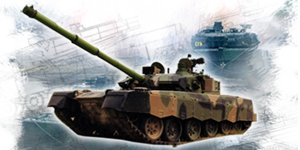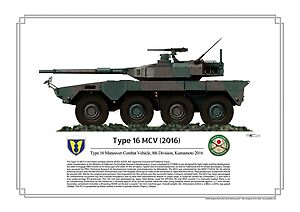The Type 10 MBT in a nutshell

Manufactured by Mitsubishi Heavy Industries, the Type 10 Hitomaru is the latest Japanese Ground Forces Main Battle Tank. It was designed to be highly mobile, network-centric and tailored for Japan’s mountainous terrain and modern battlefield needs. Advanced Mobility means a 2nd generation adjustable hydropneumatic suspension allowing the tank to kneel, lean, and tilt for better firing angles. Its lower weight of 44–48 tons depending on configuration thanks to strong usage of composite allows easier transport on Japanese roads and better maneuverability in mountainous regions. The weight was a crucial requirement, as its predecessor, the Type 90, was only deployed only in Hokkaido due to road and bridge weight limitations in Japan. The crew of three is possible thanks to an autoloader. So far 117 are listed with a first acquisition of 13 dating back 2010, 12 more ordered in 2020.
Armament
It is armed with a 120 mm Type 10 L44 smoothbore gun from Japan Steel Works (derived from a Rheinmetall gun) fully compatible with NATO ammunition for better integration, and fires fires Japan’s proprietary APFSDS and smart rounds. It is completed by a coaxial Type 94 7.62 mm machine gun aside the main gun to deal wth infantry and with tracers to backup main gun guidance. There is also on the roof a 0.5 cal. or 12.7 mm Browning M2HB heavy machine gun on the commander's station. The 14 rounds for the main gun are in the autoloader, two behind the gunner, six in the ready ammunition storage, 14 in reserve under the floor, for a total of 36 rounds carried on board.
Its Fire Control & Electronics copprises a State-of-the-art fire-control suite with automatic target tracking, Hunter-killer capability (the commander could detect and pass on targets to the gunner, and continue scanning) as well as day/night thermal imaging for all three (drive commander and gunner) with greater magnification to fire at 4 km, including on the move at speed thanks to the fully stabilized main gun. This tank was also the first fully integrated into Japan’s C4I network, allows coordinated targeting with other units.
Protection

Protection-wise, it uses a full set of modular composite armor with sandwiches of various compounds and ceramics, plastics, with easy replacement on the field. Composition is highly classified, but equivalent to c500 mm RHA depending on the ammunitions, including modern tandem warheads, ATGMS and APFSDS rounds. This protection can be tailored depending on mission, like urban combat as well. At all angles its includes protection against KE and HEAT rounds, while the V-shaped belly and suspended seats protects against IEDs and mines (to a degree). Optional active protection system (APS) components available and now an active protection system (trophy style) is in development. This in addition to collective NBC protection, automatic halon fire extinguishers and four smoke dischargers internal, forward of the turret. Rubber skirts are fitted to explode RPGs on the drivetrain sides.
Performances

Engine & Performance rests on a solid powerpack, a Mitsubishi diesel multifuel 4-stroke 22.6-litre diesel V8 MHI 8VA34WTK rated for 1,200 hp for a governed to speed of c70 km/h and a power-to-weight ratio giving it strong acceleration and agility. The Type 10 is lighter and had a much better power to weight ratio than the Type 90. It could be deployed on the southern islands of Honshu and Shikoku in addition to Hokkaido. Many analysts compared it to the earlier Leclerc for its speed and lightweight hull.
Current Status
The Type 10 entered service with the Japanese Ground Self Defense force in January 2012, with a decade-long production standing at 80 units by 2018, 177 in other sources by 2022, and it is unclear if production could resume again in case of war due to manpower issues (it takes years to train specialized engineers and workers to build a modern MBT) same issue with the French Leclerc MBT today, albeit in this case, skills were maintained until 2022. Unit cost was $11.3 million by 2022.On January 4th, 2014 the Turkish military expressed an interest to purchase its engine for the Korean based Altay. By March 2014 the deal had fallen through as Japan maintained its strict arms trading laws derived from its constitution. Albeit the Type 10 took part since 2012 in many exercises in Japan, including combined ones, it made no overseas deployments and has not been tested on the field of battle. The growing threat from China and North Korea, after the 2022 Russian invasion of Ukraine however, had changed the equation and the Type 10 is undergoing reevaluation and an upgrade program is envisioned. Final Production according to fuscal years is 139 tanks, likely in reserve, with still 80 active. Its only variant is the same chassis recovery vehicle, the Type 11 Armored Recovery Vehicle (ARV).
Type 10 MBT specifications | |
| Dimensions | 9.49 x 3.24 x 2.3 m |
| Weight | 40 tons, 48 tons fully armed and armored |
| Crew | 3 (driver, gunner, commander) |
| Propulsion | 4-stroke cycle V8 diesel engine 1,200 hp |
| Top speed | 43.3 mph (70 km/h) |
| Suspensions | Hydropeumatic, Active. |
| Range (Fuel) | 500 km est. |
| Armament | JSW 120 mm SB Gun +Type 74 coax 7.62 LMG+ Browning M2HB .50 Cal. HMG |
| Armor | Classified, Modular, Composite, see notes. |
| Production | 80 By Mitsubishi |
Gallery

Type 10 Hitomaru of the 1st Tank Battalion, 1st Division of the Eastern Army.

Type 10 with add-on armour from the 5th Tank Battalion, 5th Brigade of the Northern Army.






Type 99 SPH links & resources
The Type 10 on Wikipedianationalinterest.org massive upgrade plans
asianmilitaryreview.com
weaponsystems.net
armyrecognition.com/
army-technology.com
thaimilitaryandasianregion.wordpress.com
19fortyfive.com
Video
Video from the 2014 Firepower in Fuji event at the JGSDF’s Guji training ground featuring the Type 10. It is accompanied by Type 89 IFVs and Type 87 SPAAGs.










































